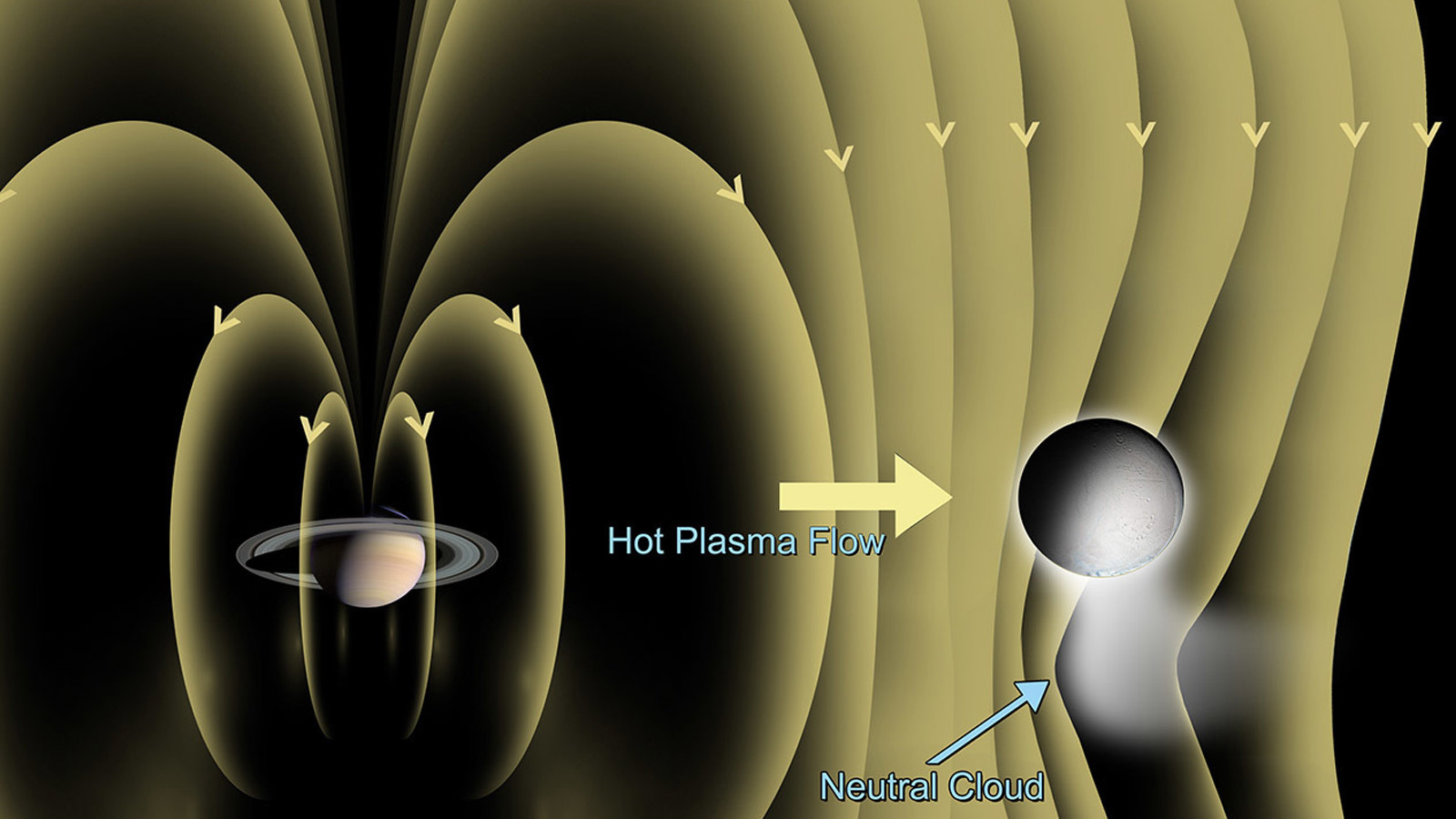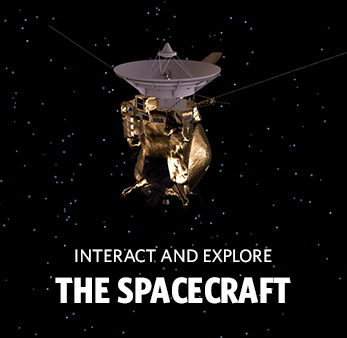
How It Worked
Like a highly-sensitive and extremely precise compass, Cassini’s Dual Technique Magnetometer, or MAG, recorded the direction and strength of magnetic fields around the spacecraft.
How We Used It
As Cassini orbited Saturn, the magnetometer recorded the varying strength and direction of the planet’s magnetic field in different locations. This helps scientists learn about the interiors of Saturn and its moons, along with the planet's magnetosphere -- the giant region of space around the planet influenced by its magnetic field. Scientists used MAG data to produce 3-D models of the magnetosphere and to shed light on how the planet's magnetic influence affects the rings, moons, dust and gas within.
Whether in New Delhi or New Jersey, a compass needle will point toward Earth’s magnetic north pole, which is not quite in the same spot as the geographical north pole. Magnetic north is one of two opposing points in a magnetic field, which is produced by a “dynamo” -- fluid movement of molten iron around the planet’s core -- and reaches far into space.
Scientists know far less about Saturn’s magnetic field than they do about Earth’s because to study a magnetic field, you must be within that magnetic field. The Magnetometer, also known as MAG, was aboard the Cassini spacecraft for that reason.
Saturn’s core is a giant ball of unknowns, largely because it’s impossible for even the burliest robotic spacecraft to reach. Lurking below thousands of miles of broiling gases and crushing liquids, Saturn’s deep interior is likely made of hydrogen and helium that’s been forced, by the crushing mass of the planet, into a metallic liquid form. And like Earth’s iron-core dynamo, because currents are swirling within this metallic fluid, it produces a magnetic field.
After Cassini arrived at Saturn in 2004, the spacecraft orbited in and out of the planet’s magnetosphere, and the MAG instrument measured its strength and direction. "Our instrument is like a very sophisticated magnetic compass traveling through space," says Dr. Nick Achilleos, a science planner and operations engineer working on the magnetometer. "Measuring Saturn's internal magnetic field often shows signatures of the boundaries which separate Saturn's magnetosphere from the solar wind -- these hold information about how Saturn's magnetosphere is continually changing in size and shape."
Because magnetometers are sensitive to magnetic fields produced by spacecraft, Cassini’s magnetometers were installed on a 36-foot (11 meter) non-metal arm called a “mag boom” to get them as far away from the spacecraft as was practical. The mag boom was folded up to fit into the launch vehicle and then unfolded about two years after launch.
The MAG instrument’s two magnetometers were even placed at different distances from the rest of the spacecraft so that their readings can be compared; this helped scientists distinguish Saturn’s magnetic field from any produced by the spacecraft. The vector/scalar helium magnetometer was at the end of the boom, and the fluxgate magnetometer was about halfway along its length.
A Magnetic Oddball
The magnetometers had complementary skills. Both could measure the magnitude and direction of magnetic fields in the spacecraft’s vicinity, but the vector/scalar magnetometer had a second mode in which it detected strength only. The flux gate magnetometer, on the other hand, could detect a range of magnetic strength nearly three times greater than the vector/scalar helium magnetometer.
Cassini’s MAG instrument confirmed that Saturn’s magnetic field is different from that of any other planet in the solar system -- its magnetic poles actually match its axis of rotation. On Earth and Jupiter, for example, magnetic north wanders away from the planet’s rotation axis by about 10 degrees, meaning that if you could see Jupiter’s or Earth’s magnetic field from space, it would appear to wobble like a hula hoop as the planet spins. Saturn’s magnetic north pole, however, is essentially in line with the planet’s axis of rotation, and it would appear to spin smoothly with no wobble. Given this orderly situation, MAG might be expected to observe a steady signal of strength and direction. But that’s not what MAG actually found at Saturn.
MAG detected a signal in Saturn’s magnetic field that repeats every 10 hours and 47 minutes. The periodic signal, called a “periodicity,” suggested that Saturn’s magnetic field isn’t really and truly aligned with the planet’s axis of rotation (what scientists call being "axisymmetric"), even though it would otherwise appear to be so. “If the field was really symmetric, you wouldn’t see periodicities,” said Marcia Burton, a magnetosphere and plasma investigation scientist at NASA’s Jet Propulsion Laboratory who works with the MAG team.
Further, a planet’s magnetic field shouldn’t be aligned with its axis of spin in the first place (according to something called Cowling anti-dynamo theory). “Physics says that it can’t happen, that it should eventually decay,” Burton said. Scientists expected Cassini to find some sort of explanation for that, Burton said. “But it’s a puzzle we still haven’t solved.”
Scientists also expected to find anomalies -- places where a magnetic field is locally distorted or twisted such that it no longer lines up with the planet’s overall magnetic field. But MAG didn't observe any such anomalies. “None that we’ve been able to detect,” Burton said. “The magnetic field is really just north-south around Saturn.”
Puzzles aside, the MAG instrument made first-time measurements of the magnetic state of Saturn’s moon Titan and its atmosphere. It also studied how Titan interacts with the outer fringes of Saturn's magnetosphere and solar wind. (Titan’s orbit sometimes carries it briefly outside of Saturn’s magnetic bubble). Saturn’s rings and dust even interact with Saturn’s magnetic environment, which MAG observed as well.
MAG was a keystone for several of Cassini’s other instruments. “It provides the context for all of the other plasma data we collect,” Burton said.
A Remarkable World
MAG also observed how Titan and Saturn’s icy moons interact with Saturn’s magnetosphere. Some of those early observations gave scientists the first hint at one of the greatest finds of the entire mission -- a liquid water ocean below the frozen surface of Saturn’s moon Enceladus.
Cassini had been in Saturn orbit for less than a year when, in February of 2005, it flew by Enceladus for the first time. MAG saw Saturn’s magnetic field bending around the south pole of Enceladus in a shape that wasn't symmetrical. This turned out to be the first definitive detection of the plume that sprays from the moon's internal ocean. Other magnetometer observations showed that the field was interacting with excited, or ionized, water vapor molecules.
“The magnetometer was really the first to detect the plume,” Burton said. Scientists later found that the plume of water particles was coming from jets at the surface of Enceladus. And further observations from the spacecraft’s dozen or so instruments led scientists to conclude that the moon has an ocean below its surface, making it one of a handful of worlds in our solar system known to harbor liquid water seas.
At a Glance
- Mass: 3.00 kg
- Average Operating Power: 3.10 W
- Average Data Rate: 3.60 kilobits/s
For more information, read the engineering technical write-up.
Cassini Orbiter Instruments
They surveyed and sniffed, analyzed and scrutinized. They took stunning images in various visible spectra. Cassini's 12 science instruments were designed to carry out sophisticated scientific studies of Saturn, from collecting data in multiple regions of the electromagnetic spectrum, to studying dust particles, to characterizing Saturn's plasma environment and magnetosphere.
Optical Remote Sensing
Mounted on the remote sensing pallet, these instruments studied Saturn and its rings and moons in the electromagnetic spectrum.
Fields, Particles and Waves
These instruments studied the dust, plasma and magnetic fields around Saturn. While most didn't produce actual "pictures," the information they collected is critical to scientists' understanding of this rich environment.
Microwave Remote Sensing
Using radio waves, these instruments mapped atmospheres, determined the mass of moons, collected data on ring particle size, and unveiled the surface of Titan.






